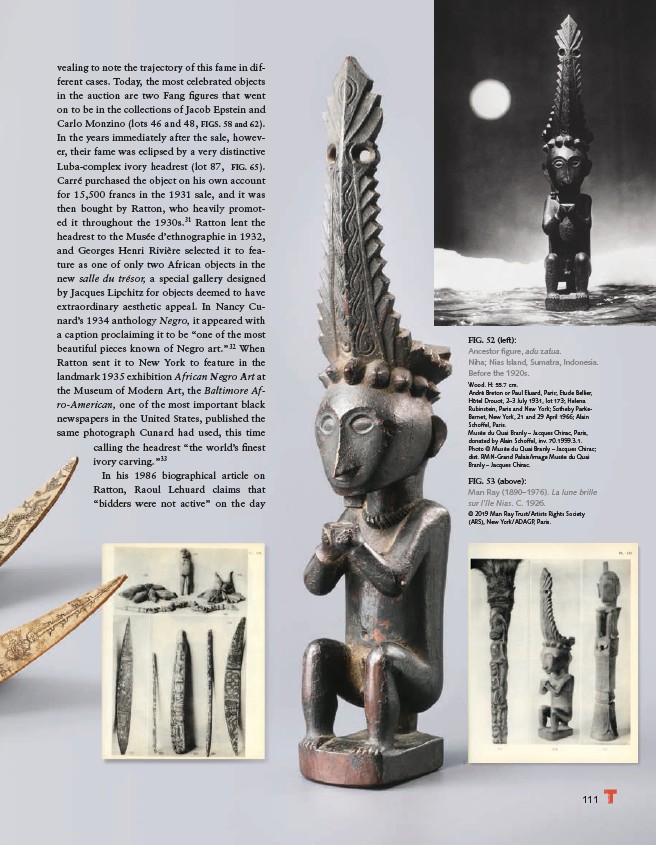
FIG. 52 (left):
Ancestor fi gure, adu zatua.
Niha; Nias Island, Sumatra, Indonesia.
Before the 1920s.
Wood. H: 55.7 cm.
André Breton or Paul Éluard, Paris; Étude Bellier,
Hôtel Drouot, 2–3 July 1931, lot 173; Helena
Rubinstein, Paris and New York; Sotheby Parke-
Bernet, New York, 21 and 29 April 1966; Alain
Schoffel, Paris.
Musée du Quai Branly – Jacques Chirac, Paris,
donated by Alain Schoffel, inv. 70.1999.3.1.
Photo © Musée du Quai Branly – Jacques Chirac;
dist. RMN-Grand Palais/image Musée du Quai
Branly – Jacques Chirac.
FIG. 53 (above):
Man Ray (1890–1976). La lune brille
sur l’île Nias. C. 1926.
© 2019 Man Ray Trust/Artists Rights Society
(ARS), New York/ADAGP, Paris.
111
vealing to note the trajectory of this fame in different
cases. Today, the most celebrated objects
in the auction are two Fang fi gures that went
on to be in the collections of Jacob Epstein and
Carlo Monzino (lots 46 and 48, FIGS. 58 and 62).
In the years immediately after the sale, however,
their fame was eclipsed by a very distinctive
Luba-complex ivory headrest (lot 87, FIG. 65).
Carré purchased the object on his own account
for 15,500 francs in the 1931 sale, and it was
then bought by Ratton, who heavily promoted
it throughout the 1930s.31 Ratton lent the
headrest to the Musée d’ethnographie in 1932,
and Georges Henri Rivière selected it to feature
as one of only two African objects in the
new salle du trésor, a special gallery designed
by Jacques Lipchitz for objects deemed to have
extraordinary aesthetic appeal. In Nancy Cunard’s
1934 anthology Negro, it appeared with
a caption proclaiming it to be “one of the most
beautiful pieces known of Negro art.”32 When
Ratton sent it to New York to feature in the
landmark 1935 exhibition African Negro Art at
the Museum of Modern Art, the Baltimore Afro
American, one of the most important black
newspapers in the United States, published the
same photograph Cunard had used, this time
calling the headrest “the world’s fi nest
ivory carving.”33
In his 1986 biographical article on
Ratton, Raoul Lehuard claims that
“bidders were not active” on the day